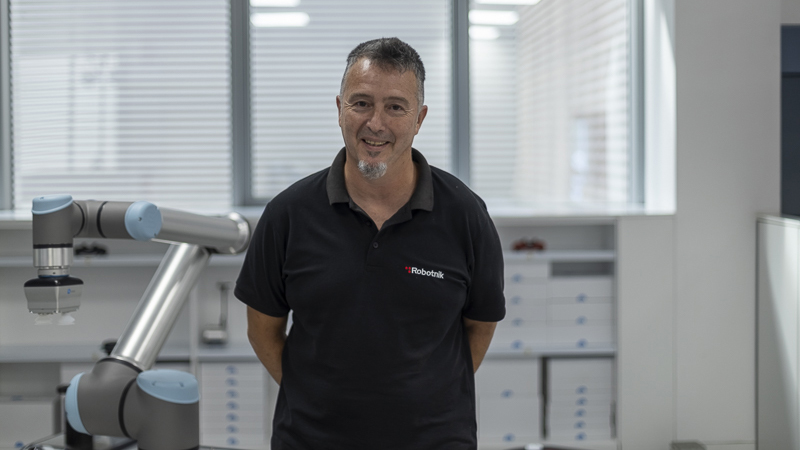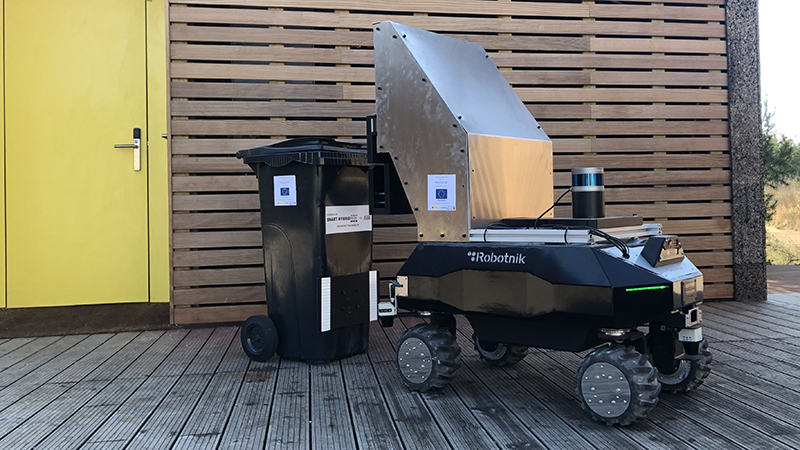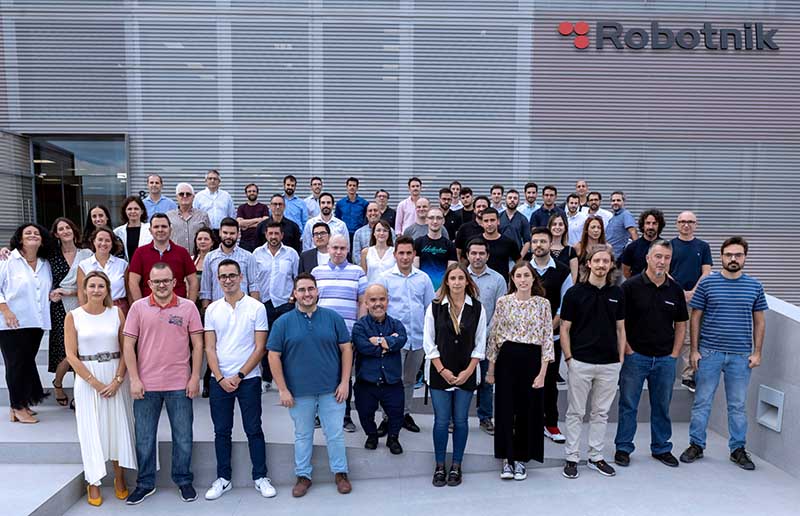Interview with Roberto Guzmán, founder and CEO of Robotnik.
The Spanish Association of Robotics and Automation – AER, publishes this month an interesting interview with Robotnik‘s CEO, Roberto Guzmán, in which he talks about the present and future of the company, the robotics sector in general and technological trends such as Artificial Intelligence.
Here you can read the full interview.
Roberto Guzmán is a Computer Engineer from the Polytechnic University of Valencia, where he also completed an MSc CAD/CAM/CAE. He has worked as a researcher in universities in Spain and Germany, and has experience as Research & Development Director, before founding Robotnik. In 2002 the company was started in Valencia, where it is still headquartered. It is also present in Korea, Japan, USA, France, Germany and Italy, among many other countries.
AER– Robotnik celebrates its 20th anniversary at a time of consolidation as a reference in mobile robotics worldwide and leader in Europe. As founder and CEO, what reflection would you make of this moment?
RG– Service robotics has been a market mainly of early adopters almost until today and the growth forecasts are very large in different segments. This is evident on a global level, so you have to consider the opportunities with some prudence. The amount of capital that has come in over the last few years has exceeded all our expectations and we think that the near future will be marked by the impact of all these investments.
Europe has a leading position in service robotics, has the largest number of companies and is a pioneer in many applications. However, investment in Europe is lagging behind that in Asia or America. Europe must react if it wants to maintain a position in this market.
AER– One of the strongest trends today is the use of robots for inspection and maintenance tasks, a development that has a direct and positive impact on the area of workplace safety. What future can we expect for collaborative robots?
RG-IFR statistics indicate that this segment grew by 35% in 2021 and is expected to grow by 45% between 2021 and 2022. The number of robots is low compared to transport, cleaning or hospital robots, but the forecast is good and we can expect a future of growth in the coming years. Right now the market is more inspection than maintenance, but this will change with the progressive introduction of mobile manipulators.
“Europe has a leading position in service robotics, has the largest number of companies and is a pioneer in many applications. However, investment in Europe is lagging behind Asia or America. Europe must react if it wants to maintain a position in this market.“
AER– In the new technological paradigm, Robotnik is betting on 5G with its 5G-ERA project, called to achieve greater autonomy of the equipment with the user at the centre. What other direct benefits would be achieved with this advance? What are the challenges of this programme?
RG-5G technology has great potential to increase the autonomy of a robot, as it allows offloading computing to the cloud and therefore using remote resources that can be shared between different robots. And why does this increase the autonomy of the robot? Because the integration of functions happens in a standard and distributed way. That robot, in order to have a new capability, such as understanding spoken language or finding objects in a hopper (bin picking), no longer has to integrate hardware with specific firmware, as these functions are provided by cloud services. The possibility to easily integrate new AI or ML functions will substantially increase the autonomy of the robot and also reduce its local computing needs.
The project addresses different challenges such as the integration of processes in OSM (Open Source MANO), the realisation of an intent-based network paradigm, the creation of cloud-native network services so that robotic applications can exploit NFV/SDN infrastructures or the accessibility of robotics experimentation facilities to third parties through standard APIs over ROS.
AER-Mobile robots are a growing trend, which will continue increasing in the coming years, as predicted by the World Robotics 2021 report. Within this group, we find AGVs and AMRs, differentiated mainly by their level of independence. Which type of mobile robotics will the market lean towards?
RG- Mobile robots (AGVs) have been present in industry since the 1970s. In 2021, for the first time, more AMRs were sold than AGVs. In the future, the trend is sure to keep moving towards higher levels of autonomy, flexibility and modularity. We will surely move from today’s AMR to the connected AMR, all systems will have better connectivity and the extension of capabilities will happen largely thanks to cloud services and software.
“Collaborative robotics is presented as a solution for any repetitive and tedious activity. Those mechanical actions (crop inspection, harvesting, spraying, etc.) will end up being performed by a robot or mobile manipulator.“
AER– Robotnik is also concerned about the environment, as demonstrated by the AUDERE project, based on the collection of solid urban waste through an intelligent system. Can this research change the course of Smart Cities?
RG– The AUDERE project focuses on the use of an autonomous mobile robot that can perform both autonomous waste collection and last-mile parcel delivery in residential areas. The automation of these two processes, rather than a change of direction, is a trend in Smart Cities. For example, in the last mile area, there are numerous products under development by companies such as Nuro, Starship, Amazon, JD or Delivers.ai.
AER– Medicine, border security, construction, sustainability… Robotnik divides its activity into different areas. Which sector will exploit the advances in mobile robotics to the greatest extent?
RG-It is true that advances are being made in basically all sectors, but for our part, we are currently focused on two industrial verticals: logistics and inspection. In both cases, mobile robotics has proven to be an excellent working tool for automating processes. What the market analyses say is that the sector that is best exploiting the advances in mobile robotics and will best exploit them in the coming years is logistics.
AER– Has Artificial Intelligence applied to mobile robotics been consolidated?
RG-It is safe to say that it has not been consolidated and that it will surely be the engine of the next revolution. AI is one of the technologies that will give mobile robotics the biggest boost. When a robot integrates AI algorithms, it doesn’t need to be given detailed commands to perform an action or make a decision, but is able to work on its own after a ‘training’ or trial-and-error phase.
Most robots are not intelligent, but in 2022, companies are no longer just looking to automate certain processes, but to automate intelligently. In many cases, a robot capable of carrying weight is no longer enough, as there is a clear trend towards mobile, autonomous robots capable of intelligently collecting, processing and managing data and making the best decisions for production.
AER– As the European market leader in robotics, what is the weight of R&D in Robotnik’s business approach?
RG– Basically, next to software, it is the most important department of the company. The continuous investment in R&D is what helps us to develop and improve our products, which in turn have a major software component, so these two departments are necessarily the most relevant in the company.
Participation in R&D projects supported by the European Union also allows us to remain at the technological forefront and to be in contact with other leading companies and research centres. This contact with other research entities and companies enriches us mutually and brings other benefits in terms of knowledge, which is ultimately the greatest value of the company.
AER– Last year saw the launch of the Warehouse Robot Lab, focused on learning and testing with the ROS software programming system, for people with prior knowledge of the subject. Why is this framework so important for Robotnik?
RG-Robotnik is a pioneer in Europe in the use of ROS in industrial products. We were working on Player-Stage at the time, and when the developer community migrated to ROS, we migrated with them. Our first modular arms worked with the ROS boxturtle distribution, the first one from Willow-Garage. Today, this framework is the standard for service robotics and it is a competitive advantage that our entire software architecture (more than 500 packages including simulation environments) runs on ROS/ROS2.
AER– Do you develop other educational options for those who are new to robotics?
RG-We direct all ROS training to our partner The Construct.
AER– How can Robotnik contribute to the development of Industry 4.0? Will the customisation of robots become more important?
RG-Robotnik contributes to Industry 4.0 by supplying connected robots and mobile manipulators and will continue to do so thanks to increased connectivity as well as cloud capabilities.
AER– What are the medium-term projects at the Valencian facility, and do you expect an even greater expansion of the international market?
RG–We currently sell 80% of our product outside Spain and this percentage continues increasing. Regarding our facilities, we moved to our new building last March and here we have 7,000 m2 of space. We are working on improving our production capacity to increase our competitiveness in the global environment.
AER– The worldwide presence will be strengthened by attending major events such as the upcoming ROSCon or IROS, which will take place in Tokyo. What can Robotnik contribute to these conferences?
RG-Certanly, these conferences are attended in order to contribute as well as to see other developments and R&D results, both from companies and research centres. Robotnik supports this event as a sponsor, as an exhibitor and, occasionally, also by presenting the results of our work, which, in general, are cases that we think can be useful for the community.
AER– To conclude, how do you value the experience of Robotnik as an AER partner?
RG-Overall, the experience is good. I think that the AER has made an effort to adapt to the needs of service robotics companies and also to those of SMEs, so I think that at the moment it represents the interests of robotics companies in Spain in a useful way.




